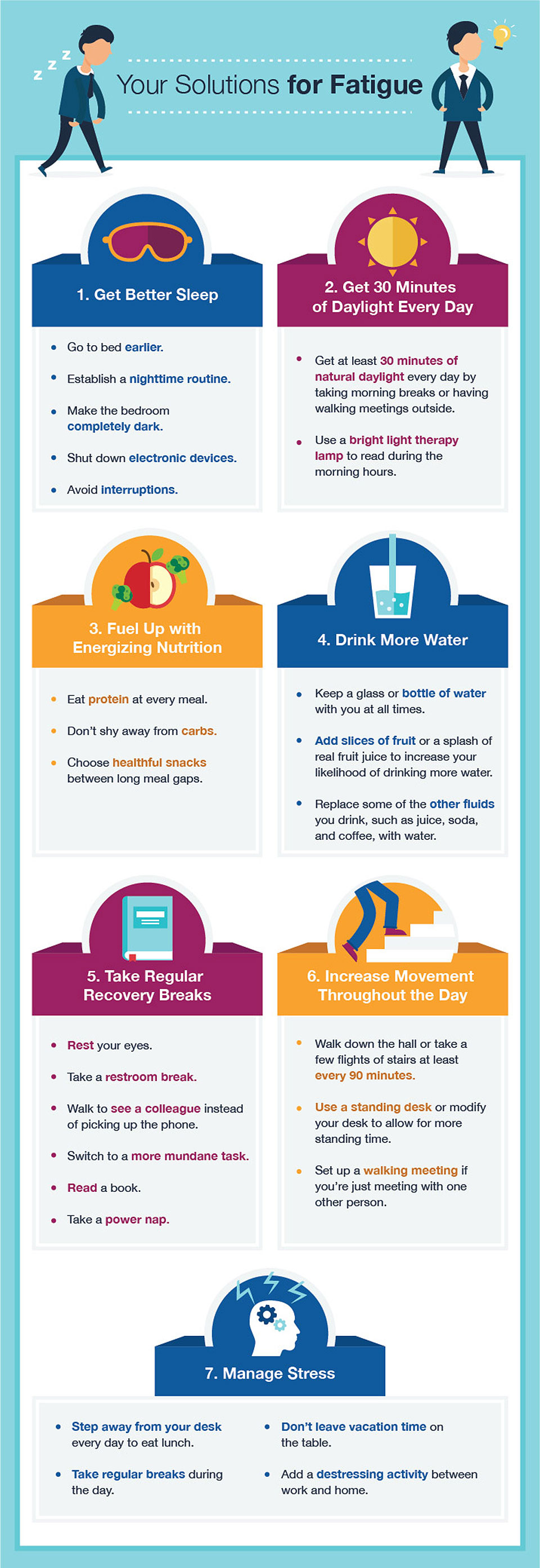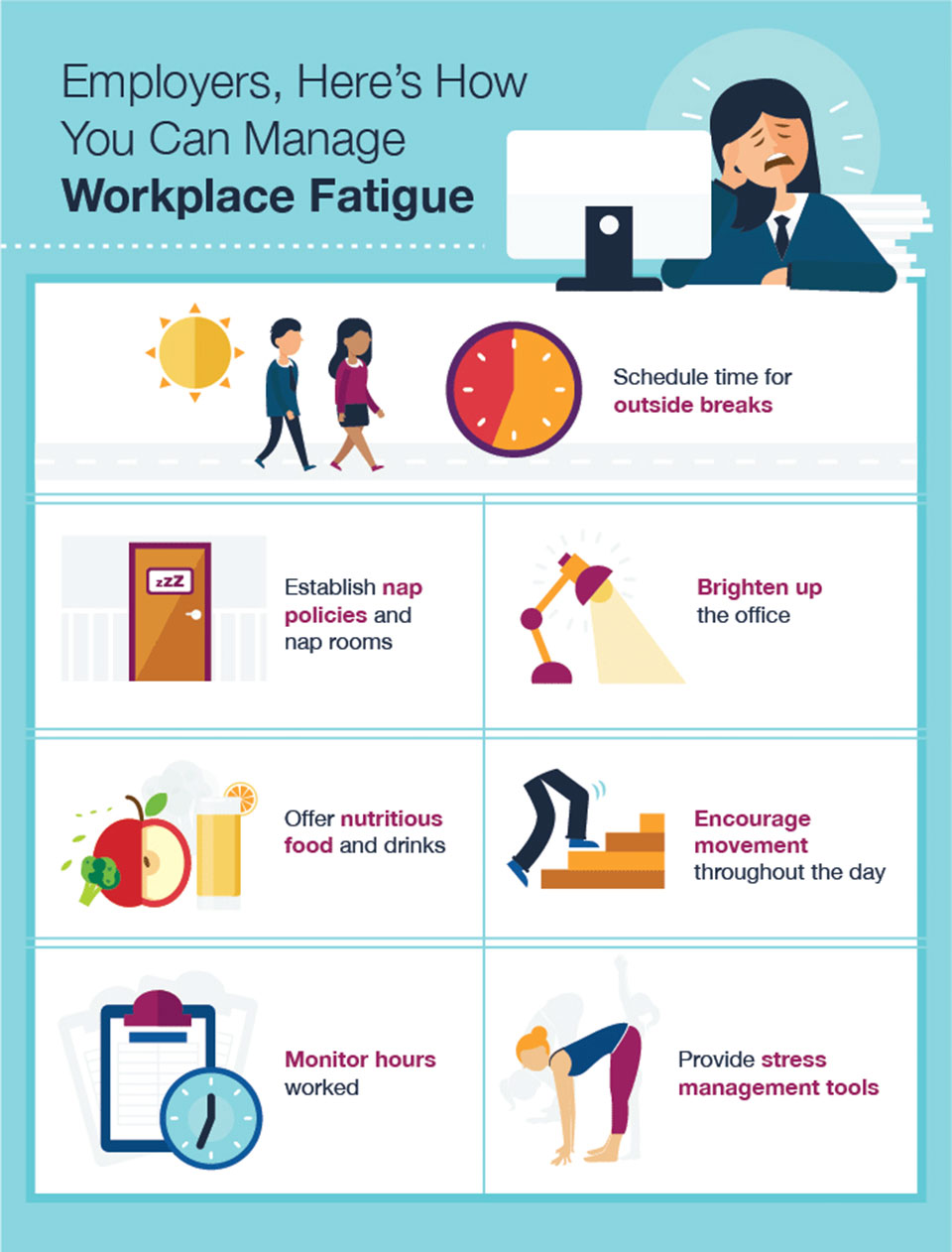In the face of budget and staff cuts, many of us have to work harder, faster, and longer than ever before. While advanced technology and time-management techniques can help, these excessive workloads ultimately result in fatigue, which leads to more illness, errors, and accidents; higher healthcare costs; and decreased productivity. In total, the global cost of fatigue has surpassed $500 billion.
When employers play an active role in keeping their employees healthy, productive, and engaged, the company is more successful. Based on a survey of 352 human resources and/or health-benefits managers in the U.S. and Canada with 1000 employees or more, the companies with the most effective health and productivity programs had 11 percent higher revenue per employee and 28 percent higher shareholder returns. Read on to learn more about employee health, productivity, and workplace fatigue.

What is Fatigue?
Fatigue isn't just about feeling tired or sleepy; it's more about lack of energy and exhaustion. It impacts physical performance by reducing reaction time and motor coordination. Fatigue also impairs mental performance, including alertness, attentiveness, and motivation.
After being awake for 17 to 19 hours, cognitive psychomotor performance becomes impaired to the same extent as having a blood alcohol level of 0.05 percent (the legal limit is under 0.08 percent in the U.S., but is 0.05 percent or less in many other countries). But it's not just lack of sleep that causes fatigue. Poor nutrition, dehydration, exertion, stress, and more can influence fatigue.
In the United States, a report of nearly 29,000 workers found 38 percent of them experienced fatigue in the past two weeks. This figure is similar in other countries, too. While fatigue is common, it is not normal.
Your Solutions for Fatigue

Fatigue can sometimes be a nonspecific symptom of a more serious problem. It's important to consult a physician to rule out medical conditions including diabetes, depression, obstructive sleep apnea, hypothyroid disease, anemia, narcolepsy, vitamin D deficiency, and undiagnosed heart disease—all of which can have some similar symptoms. Infections, such as a sinus or urinary tract infection, and uncontrolled allergies can cause fatigue too. Certain medications, including some muscle relaxants, antibiotics, sedative-hypnotics (medications to reduce tension and bring on sleep), blood-pressure medications, antidepressants, and antihistamines can also bring on fatigue.
The good news is, even if all known medical reasons are ruled out, there are ways to cope with fatigue in the workplace.
Get Better Sleep
While meetings, monotonous tasks, and long drives can be boring, they shouldn't lull anyone to sleep. If day-to-day responsibilities have you nodding off on the job, you're probably not getting enough—or the right type—of sleep. In one poll, 60 percent of responders say they have a sleep problem, such as snoring, waking up too early, waking in the middle of the night, or feeling unrefreshed, every night or nearly every night.
- Go to bed earlier
According to annual Sleep in America polls, we're getting 26 minutes less sleep than we say we optimally need. Most people say they need seven to eight hours to feel rested. - Establish a nighttime routine
Don't just shut off the lights and expect to fall asleep. Get into a relaxing routine of quiet reading or stretching before bedtime. - Make the bedroom completely dark
Because melatonin (a naturally-occurring hormone that makes us sleepy) is produced in the dark, complete darkness is critical to get a refreshing night's sleep. Since light can pass through closed eyelids, consider blackout shades or an eye mask. - Shut down electronic devices
Blue light emitted from TVs, computers, cellphones, and tablets can delay and decrease melatonin. - Avoid interruptions
Throughout the evening our bodies go through 90-minute sleep cycles ranging from light sleep to deep sleep and then back to light sleep. Any interruption, even if it doesn't fully wake you, prevents the deep sleep necessary to heal and recover.
Get 30 Minutes of Daylight Every Day
Every cell in the human body runs on a nearly 24-hour cycle. But it's not exact. On average, our bodies tend to have a 24-hour and 12-minute cycle, making it difficult to feel sleepy at the same time every day. Bright light early in the day helps the body to readjust back to a normal 24-hour cycle.
- Get at least 30 minutes of natural daylight every day by taking morning breaks or walking meetings outside
- Use a bright light therapy lamp to read during the morning hours
Fuel Up with Energizing Nutrition
Food and oxygen create the energy we need to stay alive. For peak performance, refuel with the right type of food, at the right time, in the right quantity.
- Eat protein at every meal
Every day, 1 to 2 percent of the body breaks down and needs to be rebuilt. This requires 20 to 35 grams of protein at every meal. That's equivalent to one piece of meat the size of the palm of your hand (about a 3-ounce serving), a three-egg omelet, or a veggie patty with a side of legumes. - Don't shy away from carbs
Carbohydrates turn into glucose, the fuel our brain and red blood cells run on. So it's important to add a couple servings of carbs at every meal, including whole grain bread, pasta, and rice, and plenty of fruits and vegetables. If you don't eat enough carbohydrates, the body converts protein into the required amount of glucose. - Choose healthful snacks between long meal gaps
When it comes to having consistent energy throughout the day, many of us are better off eating smaller meals and snacks. Healthy snacks include yogurt, fruit, raw veggies and hummus, fruit and low-fat cheese, and air-popped popcorn.
Drink More Water
Since the human body is 60 percent water, mild dehydration (as little as 1 percent) can negatively impact alertness, mood, and concentration.
- Keep a glass or bottle of water with you at all times.
- Add slices of fruit or a splash of real fruit juice to increase your likelihood of drinking more water.
- Replace some of the other fluids you drink, such as juice, soda, and coffee, with water.
Take Regular Recovery Breaks
The human body continually experiences 90-minute cycles in alertness, not only during sleep but during the day as well. Therefore, we tend to be more productive if we work hard for about 90 minutes and then take a short break to reboot energy and improve mood, willpower, creativity, and decision-making abilities. Breaks can include:
- Resting your eyes
- Taking a restroom break
- Walking to see a colleague instead of picking up the phone
- Switching to a more mundane task
- Reading a book
- Taking a power nap
Increase Movement Throughout the Day
Movement improves energy, mood, memory, body composition, health, and productivity. The more you sit, the greater your risk for heart disease, diabetes, cancer, and death from all causes. That relationship holds true for regular exercisers who work out for an hour but still spend a lot of time sitting.
- Walk down the hall or take a few flights of stairs at least every 90 minutes
- Use a standing desk or modify your desk to allow for more standing time.
- Set up a walking meeting if you're just meeting with one other person.
Manage Stress
Stress isn't caused by what happens to us; it's based on how we think about what happens to us. In response to danger, the body promptly responds with the fight or flight reaction. While the reaction can be lifesaving, experiencing it over and over again is actually life threatening and exhausting. To help manage and prevent stressful thoughts and feelings:
- Step away from your desk everyday to eat lunch.
- Take regular breaks during the day.
- Don't leave vacation time on the table.
- Add a de-stressing activity between work and home, such as reading a leisure book on the train ride home, stopping off at a park for a walk, or meditating in your parked car before coming into the house.
As an Employer, Here's What You Can Do

Schedule Sleep Regulations
About one-quarter of transportation workers, including pilots, train operators, and truck drivers, admit sleepiness has affected their performance at least once a week (versus 17 percent for non-transportation workers). Factors involved include getting fewer hours of sleep, long work days, and having less time between shifts—all of which can be improved by implementing and maintaining industry guidelines.
Institute Sleep Testing and Treatment
Long-haul drivers were twice as likely to be obese than the national working population, which increases the risk for obstructive sleep apnea. Schedule sleep screening and treatment.
Establish Nap Policies and Nap Rooms
In the 1990s, NASA experimented with the use of naps during long flights and found that 26 minutes of sleep improved cognitive performance by 34 percent and alertness by 54 percent. Currently, airline pilots on international flights alternate taking short naps to stay alert. More recent research shows brief naps (five to 15 minutes) can reduce sleepiness and improve cognitive performance for up to three hours afterward. Napping seems to be more beneficial for people who regularly nap, compared to people who only do so on occasion.
Brighten Up the Office
Bright lights at work help keep people alert, especially when working a shift outside of daytime hours. Because nighttime sleepiness increases errors and slows reaction time, bright lights are recommended to counter some of these effects.
Offer Nutritious Food and Drinks
Providing free or reduced cost meals and snacks encourage employees to stop and refuel. Offer healthy options in the break room, such as fresh or dried fruit, unsalted nuts, bean chips, popcorn, hummus and raw veggies, Greek yogurt, and bars with simple ingredients like fruit and nuts. Provide easy access to chilled, filtered water coolers, herbal teas, coffee, and more.
Encourage Movement Throughout the Day
Fitness isn't just important for employees' physical health. Regular movement improves energy, mood, memory, and productivity.
- Provide an onsite fitness center or discounts to local gyms.
- Encourage movement at work by offering safe stairwells and on-property walking paths.
- Use standing-height conference tables in meeting rooms to offer an alternative to sitting.
- Offer stand-up and/or walking desks.
- Provide organized short physical-fitness breaks or classes in the middle of the day.
Monitor Hours Worked
Contrary to popular belief, working more than 60 hours a week does not improve productivity. It only increases stress and burnout.
- Offer flexible work hours so employees can work when they are the most productive.
- Encourage employees to use all their vacation days.
- Put half-day Fridays into effect.
- Consider a flex work-from-home policy.
- Enact longer paid maternity and paternity leave.
- Allow sabbaticals after years of employment.
Provide Stress Management Tools
The "fight or flight" response of our stress hormones allows us to maneuver a vehicle out of a potential crash (fight) or face the urge to run out of the room when ill prepared for a meeting (flight). While sometimes life saving, the initial sharp state of alertness from a stress response can leave you exhausted. Here are some proven strategies to release the stress hormones from your body.
- Set up stress-reduction classes.
- Hold in-office yoga classes.
- Provide unlimited free phone counseling for personal or professional issues.
- Create meditation or nap rooms to be used during morning and afternoon breaks.
- Set up a "fun room" or equip your break room with non-work activities such as Ping-Pong tables, foosball, and basketball hoops.
Conclusion
While energy slumps are natural during the day, they don't have to be so severe that productivity suffers. With just a few changes in the way you eat, think, move, and sleep you can keep your energy up all day long.
Share this infographic on your site
Dr. Jo Lichten PhD
Dr. Jo Lichten PhD speaks to professionals who have achieved great success in their career at the expense of their health and personal life. In her keynotes and workshops she provides practical strategies and motivation to help them stay healthy, sane, and productive. Jo is the author of five books including REBOOT — how to power up your energy, focus, and productivity. She also consults with Johnson & Johnson Human Performance Institute. You can reach Jo at DrJo.com.


